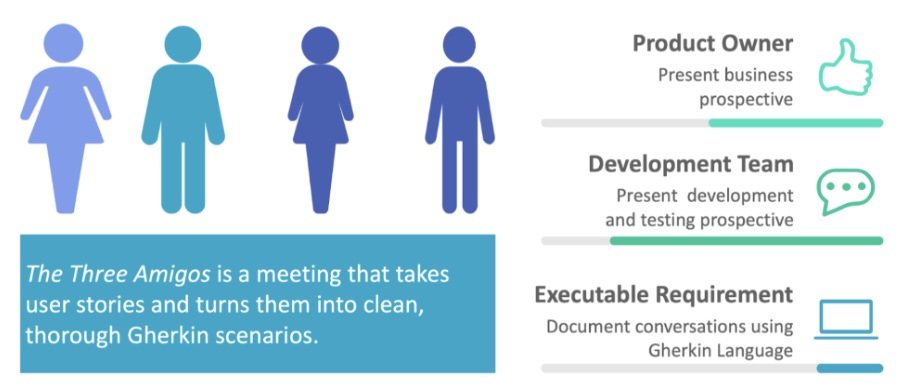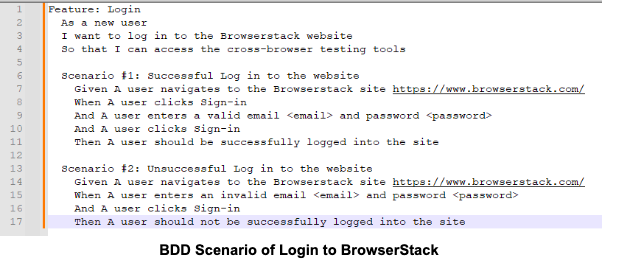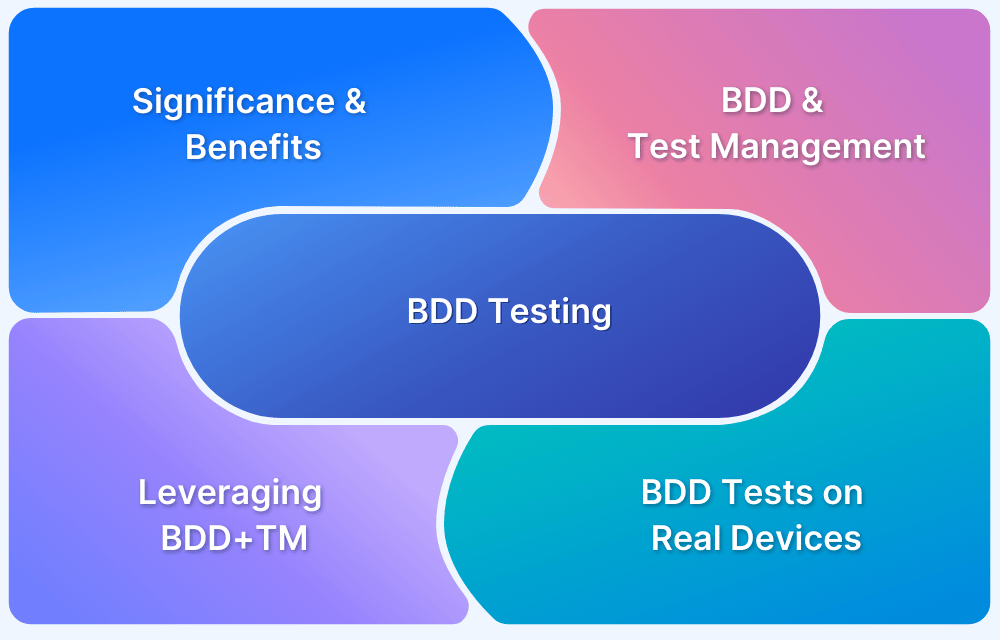Behavior-Driven Development (BDD) is gaining popularity in modern software development due to its collaborative approach. It extends traditional Test-Driven Development (TDD) by emphasizing the software’s behavioral aspects to make sure that its features blend well with business goals.
Overview
What is Behavior Driven (BDD) Testing?
BDD Testing refers to a testing approach that leverages behavior-driven development to align tests with business goals. In this testing approach, scenarios are written in plain language and this drives clarity and collaboration among developers, testers, and stakeholders.
Popular BDD Testing Frameworks
- Cucumber
- Behave
- JBehave
- SpecFlow
- Concordion
- FitNesse
In this guide, learn what is BDD testing, how it differs from BDD, its working, how to perform it and the best BDD testing frameworks.
What is BDD?
Behavior-driven Development (BDD) is a software development methodology that emphasizes collaboration between developers, testers, and business stakeholders to ensure that software meets the desired outcomes and behaviors. BDD extends traditional Test-Driven Development (TDD) by focusing on the behavioral aspects of the software and ensuring that the features are aligned with business goals.
It was ideated to combat issues derived from ill-defined requirement specifications and bring business and QA professionals on the same page. BDD and TDD testing both follow a sort of “contractual mechanism” to ensure that any output matches a particular expectation.
Though the term “behavior” might be highly familiar, it acquires a specific technical meaning in this context.
What is BDD Testing?
BDD Testing refers to a testing approach that leverages behavior-driven development to align tests with business goals. In this testing approach, scenarios are written in plain language and this drives clarity and collaboration among developers, testers, and stakeholders.
For BDD Testing, behaviors are a set of well-articulated, human-understandable statements that define a specific process in a predetermined format. These are stored in a “feature files” set that is then integrated into the software development process. Usually, these files are written in Gherkin, a special syntax used in BDD to allow tools like Cucumber and SpecFlow to automatically validate the “behaviors” encoded for a process.
However, the BDD approach in testing focuses on defining the application’s behavior to make it optimal for business needs rather than the high test coverage-focused principles of TDD.
Read More: How to achieve Advanced BDD Test Automation
Features of BDD Testing
BDD Testing can help users achieve advanced automation capabilities. Here are some of the beneficial features:
- Modular Test Case Design: Making test cases more modular by repeating common scenario steps and writing them only once. This is especially useful for writing Regression Testing scenarios.
- Parallel Test Execution: Allows Parallel testing to boost test run times. For example, tools like BrowserStack Automate allow sequential and parallel execution of Cucumber-based Espresso tests. These can be split into groups called shards and executed in parallel to drastically reduce timelines.
- Data Tables: Allows for comprehensive use of Data Tables to store test data for automated execution. This is again very beneficial for Regression Testing as this allows the scenarios to be tested for various situations.
- Business requirement mapping in Jira: Allow for better test coverage by mapping business requirements in JIRA and other project management tools to test cases within the Feature File itself. User Stories can be integrated by ID into BDD scenarios for directly mapping business requirements to test cases and subsequently into automated test scripts.
BDD vs. BDD Testing
BDD is a software development methodology that helps testing or development teams collaborate for defining software behavior using clear, human-readable scenarios before the development efforts commence.
However, BDD Testing refers to writing and running tests based on the behavior scenarios outlined in the BDD process. This testing approach verifies if the application behaves as intended as per the scenarios.
Why do you need BDD Testing
Agile Processes and DevOps are primarily concerned with building products in the shortest period possible. However, organizations are wary of pushing out builds that do not fully satisfy customer needs or fail to align with strategic business goals.
- BDD buttresses Agile methodology by allowing constant end-user input to validate the development process and ensure that the “right product” is being deployed.
- It also allows for greater coordination between key stakeholders in the Software Development Process, viz. The Business Team, the Development Team, and the QA Team. These three stakeholders are often called the “Three Amigos”.
Source: Scrum.org
- Most testing performed using scripting and/or programming languages is not readily perceptible by non-technical stakeholders. Often this leads to a greater onus on QA teams to explain their work in layperson’s terms or, worse, in critical business requirements being misinterpreted. Leveraging the communicative power of tests written in plain English, BDD software testing allows all stakeholders to be on the same page at all times.
How does BDD Testing work: The Process
BA/SME teams create Feature files in domain-specific language, and then the Dev, BA, and QAE teams concur on the Feature and Scenarios. QA creates BDD tests for the same scenarios using the same tools and framework as the Dev team.
Every time a build is created, these tests are executed as part of Continuous Integration, and the results are then shared with the entire Sprint team.
Once the client or stakeholders are satisfied with the requirements, Gherkin is used to convert them into Feature files. The feature file is the starting point for the tests, functioning as both a script and a document. It may include a scenario or a list of possible scenarios.
Tools like Specflow and Selenium are sometimes utilized to convert these Scenarios into Step Definitions. Depending on the BDD tool like Cucumber or Behave, every line in the Feature file is transformed into methods, and code can be developed using Selenium and C#. When sufficient Scenarios have been covered, it is deemed deployed for all Sprint teams.
Read More: BDD vs TDD vs ATDD : Key Differences
What is the Gherkin language?
Gherkin is basically a domain-specific language that outlines test cases in a human-readable format, mainly for behavior-driven development (BDD).
Gherkin has a structured syntax that leverages simple, clear language to elucidate system behavior This bridges the gap between technical and non-technical team members letting both the parties contribute to the specifications of a software application.
Gherkin scenarios are usually written in a Given-When-Then format, that describes the initial context, the action taken, and the expected outcome.
How to Perform BDD Testing in Cucumber: Example
Now that a basic introduction to BDD Testing and its importance has been established, it is vital to understand the rubrics of how BDD Testing is performed.
The popular Cucumber- Selenium- Java Framework for BDD Testing is demonstrated for this example.
The scenario is a successful login to the BrowserStack Website.
Pro Tip : For guidance into the Prerequisites to set up the BDD testing framework, please refer to the article on Test Automation using Selenium and Cucumber.
Here’s how you can perform BDD testing via the three Major parts of the Cucumber Framework:
1. The Feature File
A single functionality is defined in BDD as a feature. These features are written in the Gherkin syntax using the Given, When, Then logic, and are stored in feature files with the extension “.feature”
This file stores details about the features, the description of the feature in simple language, the scenarios to be tested, and any pertinent data for testing the feature.
Feature: Login to Browserstack
Description: The user shall be able to login to Browserstack after entering the correct username and password.
As a new user
I want to log in to the Browserstack website
So that I can access the cross-browser testing tools
Scenario #1:
- Successful Log in to the website
- Given A user navigates to the Browserstack site https://www.browserstack.com/
- When A user clicks Sign-in
- And A user enters a valid email <email> and password <password>
- And A user clicks Sign-in
- Then A user should be successfully logged into the site
Scenario #2:
- Unsuccessful Log in to the website
- Given A user navigates to the Browserstack site https://www.browserstack.com/
- When A user enters an invalid email <email> and password <password>
- And A user clicks Sign-in
- Then A user should not be successfully logged into the site
2. Step Definitions
Once the features are set down in the feature files, the code for the scenario needs to be executed.
Step Definitions store the data mapping between each step of the scenario defined in the feature file and the code that needs to be executed to verify it.
Both Java and Selenium commands can be used to map the feature file to executable code.
package StepDefinition;
import cucumber.api.java.en.Given;
import cucumber.api.java.en.Then;
import cucumber.api.java.en.When;
public class Steps
{
@Given("^a user navigates to the browserstack page by opening the browser$")
//Code to Open any browser and launch the login page of application to define the GIVEN step of the feature
@When("^user clicks on the login button$")
//the login button is identified using the find element of the XPATH and is clicked to go to the login page
@When("^user enters correct username and password values$")
//the inputs for the username and password fields are placed into the correct web elements using XPATH. The WHEN step of the feature is being executed here.
@Then (“^user gets directed to homepage$”)
//Direct to the Homepage of the application as a result of correct username and password inputs in the WHEN step. This would define the THEN step of the feature
}3. Test Runner File
The Test Runner File is required to run the test. In this case, a JUnit Test Runner Class has the step definition location and the other metadata required to execute the test.
The @RunWith() Annotation in JUnit is required to execute these tests, and the @CucumberOptions Annotation is used to define the locations of the feature files, step definitions, reporting integrations, etc.
For Example:
Test Runner Class in cucumberTest package, with the feature files in “src/test/Feature” location and Step Definition files in “src/main/stepDefinition” folder.
package cucumberTest;
import org.junit.runner.RunWith;
import cucumber.api.CucumberOptions;
import cucumber.api.junit.Cucumber;
@RunWith(Cucumber.class)
@CucumberOptions(
features = "src/test/Feature"
,glue={"src/main/stepDefinition"}
)
public class TestRunner {
}Pro Tip: Browserstack Automate can allow users to run BDD tests on the Cucumber-Java-Selenium Framework on more than 3500+ real devices and browsers.
Read More: How To Use Annotations In Cucumber Framework
Popular BDD Testing Frameworks
BDD Testing Frameworks are tools that aid in executing Behavior-Driven Development by letting testers and developers write human-readable test cases (mostly in plain English). These test cases can be directly turned into automated tests. These tools mostly use Gherkin syntax (Given-When-Then format) to describe behaviors and scenarios.
Here’s a list of Popular BDD Testing Frameworks:
1. Cucumber
Cucumber is one of the most widely used BDD frameworks. It allows users to write test scenarios in Gherkin language, which is a simple, human-readable syntax. Gherkin is a domain-specific language for behavior descriptions.
Cucumber integrates with various test runners and automation tools to execute these scenarios.
Language: Java, Ruby, JavaScript, Python, PHP, Perl, Swift, .NET, C++.
Features:
- Supports feature files written in Gherkin syntax.
- Extensive ecosystem with plugins and integrations.
- Good support for multiple languages and platforms.
2. Behave
Behave is a BDD framework for Python that uses Gherkin language for writing scenarios. Behave integrates well with Python’s testing ecosystem and is suitable for both web and non-web applications.
Language: Python
Features:
- Supports Gherkin syntax.
- Integration with popular Python testing libraries.
- Provides easy-to-use command-line tools for running tests.
3. JBehave
JBehave is a BDD framework for Java that allows writing scenarios in a natural language format. JBehave provides its own way of defining stories and steps, which are then mapped to Java code for execution.
Language: Java
Features:
- Supports scenarios written in a natural language.
- Integration with various testing frameworks like JUnit.
- Offers flexibility in defining and managing stories and steps.
4. SpecFlow
SpecFlow is a popular BDD framework for .NET applications. It allows you to write test scenarios in Gherkin language and bind them to C# code. It integrates well with various .NET test runners and CI/CD pipelines.
Language: .NET
Features:
- Supports Gherkin syntax for writing scenarios.
- Integrates with NUnit, xUnit, and MSTest.
- Provides rich integration with Visual Studio and Azure DevOps.
5. Concordion
Concordion is a BDD framework for Java that combines executable specifications with documentation. Concordion allows you to write test scenarios in HTML and integrates them with Java code for execution.
Language: Java
Features:
- Supports writing tests in HTML format.
- Provides detailed reports and documentation.
- Integrates with Java-based test runners.
6. FitNesse
FitNesse is a web-based testing framework that supports BDD principles. It allows writing test cases in a wiki-style format and supports integration with various testing tools and frameworks.
Language: Java
Features:
- Wiki-based interface for writing and managing tests.
- Integration with FitLibrary and other testing libraries.
- Provides a collaborative environment for writing and executing tests.
Future Trends in Behavior-Driven Testing
BDD Testing is also evolving to meet new demands. Here are BDD testing trends you can expect in the near future:
- AI-powered Scenario Generation: AI and machine learning will leverage user stories, requirements, or existing documentation to auto-generate BDD scenarios.
- Increased Shift-Left Adoption: BDD aligns well with shift-left testing wherein the testing efforts will start earlier in the development cycle. This will help testing and development teams collaborate better to get clear insights.
- BDD for Microservices and APIs: BDD will be extending beyond UI tests and functional tests to venture into microservices and API testing. This facilitates behavior specifications for distributed systems and complex architectures.
Read More: Top 20 AI Testing and Debugging Tools
How to write Test Scenarios in Gherkin?
Test Cases and Test Scenarios for the BDD testing framework are envisaged similarly to those written for standard test cases. However, the key difference is in the Gherkin syntax used for articulating them.
Stakeholders initially discuss the product requirements with the developers and testers and decide upon the scenarios that are suitable to be tested. These scenarios are then written as feature files for the automation test tool and are utilized as automated acceptance tests.
The three keywords leveraged for this purpose are –
Given (to provide the context for the scenario) When (to specify the action being performed) And, Then (to represent the desired outcome)
Some further descriptors can be added to this trio to flesh out the scenario even more with the use of And
Given ( some initial context), And (some further context), When (the primary action/event), And (some further action/event), Then (initial outcome) And (further outcome)
Using this logic exhaustive test scenarios can be codified for BDD Testing. Below is a scenario for successful and unsuccessful login to the Browserstack site.
Advantages and Limitations of BDD Testing
Some of the primary advantages of BDD Testing are as follows –
- Fosters Effective Communication and Collaboration by adopting an easy to understand, declarative style of communication to bring technical and non-technical stakeholders on the same page.
- Speeds up Product Delivery by closing the understanding gap between technical and business stakeholders and leading to rapid creation of automated test cases that all the stakeholders can agree upon.
- Reduces human errors in a software implementation by ensuring that the business requirements are hard coded in a readable format for all tests executed.
However, no process is perfect, and BDD also has a few limitations.
- Gives rise to excessively tightly coupled behavior arising from protracted meetings between the stakeholders and the need to include all key stakeholders in the BDD process.
- Requires meticulously prepared software requirements for the Gherkin scripts to effectively articulate the business requirements. This can sometimes be contrary to the rapid pace of Agile teams working off brief specs.
Why perform BDD Testing on Real Devices?
You should run BDD Tests on a real device cloud like BrowserStack Automate for below reasons:
- Realistic Testing Conditions: Real device clouds provide access to a broad spectrum of devices and environments, ensuring tests reflect actual user conditions accurately.
- Enhanced Security: Maintained with high security standards, real device clouds offer secure, isolated testing environments, minimizing data breach risks.
- Broad Browser and OS Coverage: Helps identify compatibility issues across various browsers and operating systems, enhancing user experience.
- Performance Insights: Real devices yield authentic performance data essential for optimizing application responsiveness.
- Scalability and Accessibility: Facilitates scalable and accessible testing, suitable for distributed teams.
- CI/CD Integration: Integrates smoothly with CI/CD pipelines for continuous testing and early issue detection.
- Cost-Effectiveness: Although initially more costly, it saves on long-term expenses related to fixes and support.
Conclusion
While Agile processes and Test Automation are key in reducing product delivery timelines and satisfying the demands of an expectant user base, it is crucial to deliver the product exactly as the customers demand.
- BDD testing framework in combination with Agile methods, ensures that the “right product is shipped off in the right manner”.
- Also, its use of natural language scenarios make it ideal for user acceptance testing.
Like with all other tests, it is essential to execute BDD Tests on real browsers and devices for the best results. BrowserStack not only supports BDD Testing on the Selenium Framework, but also provides a Cloud Selenium Grid of 3500+ devices for mobile and web testing.
Frequently Asked Questions
1. What is BDD vs TDD in testing?
Test Driven Development (TDD) is a software development practice where developers write automated tests before writing the actual code that needs to be tested.
BDD is a software development methodology that helps testing or development teams collaborate for defining software behavior using clear, human-readable scenarios before the development efforts commence.
While TDD sees to it that every piece of code functions as expected, BDD verifies that the application as a whole runs as expected by the team and users.
2. What is the BDD process in agile?
In Agile, BDD defines and tests software behavior through effective collaboration between developers, testers, and business stakeholders. Clear, example-based scenarios are written before development begins.
Here’s how the BDD process flows:
- The teams collaborate to analyze user stories and specify expected behaviors using real-world examples.
- The behaviors are then written down as scenarios via plain language (Gherkin Syntax) to promote shared understanding.
- The scenarios are then automated as executable tests using BDD frameworks.
- These tests are continuously run all through the Agile Cycle to ensure new code meets the defined behavior.









